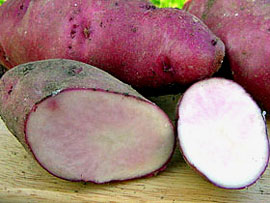
'Cranberry Red' ('All Red') is an early, red-skinned variety. It has a moist, white flesh with a red blush. The red color holds well during cooking.
The common, white-fleshed, "Irish" potato has a reputation for being inexpensive, plain, and boring, so why bother growing potatoes? Well, there's more to potatoes than meets the eye. This worldwide staple food is easy to grow, productive, and can excite you with vivid colors. Potatoes aren't just white any more. New and reintroduced heirloom varieties allow you to grow spuds in a rainbow of colors, including red, yellow, blue, and purple. Imagine making a red, white, and blue potato salad for the 4th of July? How about purple mashed potatoes to thrill your kids? Not only are the colors interesting, the shape, flavor, and texture varies depending on the variety. Some tubers are small and succulent and great for roasting. Other varieties are large and oval, perfect for baking. Whichever variety you grow, you'll marvel at their ease of cultivation and the fresh flavor of your newly harvested spuds.
Nutritionally, this South American native has gotten a bad rap. It's not because of the nutrient and health qualities of the basic tuber, but because of the things that we put on them, such as butter, sour cream, and bacon bits. Potatoes are nutrient-dense and loaded with vitamin C, vitamin B6, and potassium. They are good sources of iron and recent research shows they contain phytochemicals, such as kukoamine, that reportedly help lower blood pressure.
Plus, they're fun to grow with kids. One of the few garden tasks my daughter helped me with when she was younger was harvesting potatoes. It was like a treasure hunt looking for the buried spuds. So grow some potatoes next year and enjoy the satisfying harvest.
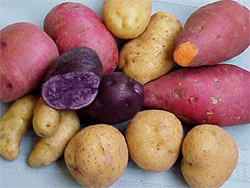
Enjoy a wide selection of tasty spuds by choosing potatoes in a variety of colors.
Potatoes are in the same family as tomatoes, peppers, and eggplants, but, unlike their Solanaceous cousins, potatoes grow best in cool conditions. While most other vegetables are started from seed, potatoes are usually grown from small tubers ("seed potatoes"). Buy certified disease-free tubers from your local garden center or through the mail. Don't plant store-bought potatoes because they're sprayed with a sprouting inhibitor.
Select varieties based on their usage. Red-skinned potatoes or yellow-fleshed spuds tend to have moist flesh and are good for mashing and boiling. Russet potatoes have scaly skin and a dry flesh. They are good for baking. Fingerling potatoes are small and great for roasting. Plant a row of different types to add color and variety to your potato crop.
Here are some varieties to grow in your garden. Potato varieties are classified by their maturity dates as early (65 days), mid-season (70-80 days) or late season (90+ days). Plant a selection to extend your harvest.
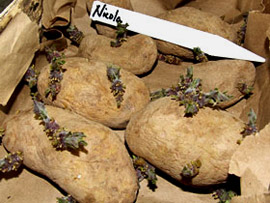
Pre-sprout your potato tubers for a few days before planting to make them grow faster. The faster they grow, the less likely they are to get tuber rot from wet soil conditions.
Choose a sunny, well-drained site with slightly acidic soil. Avoid adding any high-nitrogen fertilizers before planting because these can inhibit tuber formation and lead to diseases.
PlantingPre-sprouted tubers grow faster than unsprouted ones. To pre-sprout your tubers, place them in a sunny window for two or three days before planting. Plant outdoors two to four weeks before the last spring frost date in your area. In warm regions you can also plant a fall crop in late summer. Plant small tubers (those less than 2 inches in diameter) whole. Cut larger tubers into pieces so that each section has at least two "eyes," or sprouts. Cut pieces the night before planting so they form a callus on the cut end to prevent the tuber from rotting. Place the tubers in 4- to 6-inch-deep trenches, spacing the tubers 12 to 15 inches apart in rows 2 feet apart. Cover with 2 to 4 inches of soil.
If you don't have room to grow potatoes in the ground, try growing potatoes in a container. It's a fun activity for kids.
Care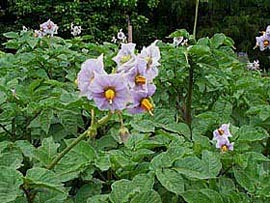
Potato plants have beautiful flowers, making them a nice addition to the ornamental garden. The first new potatoes are ready for harvest when plants start to bloom.
Keep the soil evenly moist until tubers sprout — usually within 1 week. When the plants are 6 to 8 inches tall, "hill" them by hoeing soil right up to the plants, burying the stems so just the top leaves show. Hill again 2 to 3 weeks later. Hilling provides extra space for tubers to form and removes weeds at the same time. After the final hilling, mulch the plants with a 2- to 4-inch-thick layer of hay or straw. This will keep the soil evenly moist and minimize problems with hollow heart in the tubers. Also, the mulch will shade any exposed tubers from the sun. Prolonged sun exposure causes green patches to develop on the tuber's skin. (The tuber is still edible after you peel the green part away.) Fertilize only if the soil is low in potassium and phosphorous. Avoid adding nitrogen fertilizer.
Potatoes are attacked by a number of insects and diseases. Check plants for signs of the Colorado potato beetle by looking for orange eggs on the undersides of leaves. Crush the eggs, handpick potato beetle adults, and spray Bacillus thuringiensis 'San Diego' on the young red larvae. Control leafhoppers with sprays of insecticidal soap. Harvest early to avoid damage from burrowing pests, such as mice and voles.
Rotating crops can help control diseases; avoid planting potato-family crops in the same location more than once every three years. Clean up and destroy old tubers and plants. Select disease-resistant varieties and to minimize problems potato scab, keep the soil pH around 6. Scab disease doesn't like acidic soil.
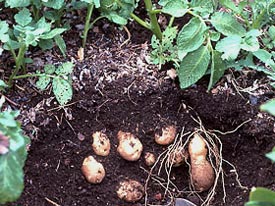
When plants start to die back, gently dig around the roots to discover the buried treasure that lies in waiting.
Harvest 1- to 2-inch-diameter spuds as "new" potatoes six to eight weeks after the plants begin growing. Excavate lightly next to the plants and gently dig out a few tubers from each plant. Cover the hole and let the rest of the tubers mature.
Harvest mature tubers once the plants start dying back. Use a garden fork to carefully dig around the plants to find the potatoes. Place the tubers in a dark, humid, 70- to 80-degree F room to cure for two weeks. Gently remove any soil and store them in a dark shed, garage, or basement at 40 degrees F for up to 9 months. Cull out any diseased, damaged, or cut tubers; they will not store well.
Other great potato stories:Compost Reduces Potato Diseases
Red, White and Blue, Plus Yellow and Purple, Too
 Charlie Nardozzi is an award winning, nationally recognized garden writer, speaker, radio, and television personality. He has worked for more than 30 years bringing expert gardening information to home gardeners through radio, television, talks, tours, on-line, and the printed page. Charlie delights in making gardening information simple, easy, fun and accessible to everyone. He's the author of 6 books, has three radio shows in New England and a TV show. He leads Garden Tours around the world and consults with organizations and companies about gardening programs. See more about him at Gardening With Charlie.
Charlie Nardozzi is an award winning, nationally recognized garden writer, speaker, radio, and television personality. He has worked for more than 30 years bringing expert gardening information to home gardeners through radio, television, talks, tours, on-line, and the printed page. Charlie delights in making gardening information simple, easy, fun and accessible to everyone. He's the author of 6 books, has three radio shows in New England and a TV show. He leads Garden Tours around the world and consults with organizations and companies about gardening programs. See more about him at Gardening With Charlie.
 Victory Seed Company has all the seeds you want for your best garden in 2024.
Victory Seed Company has all the seeds you want for your best garden in 2024.
For 25 years, the family-owned Victory Seed Company has provided the highest quality vegetable, herb and flower seeds to families across the country. We are passionate about providing you the best seeds available that give excellent germination, robust plants, and the harvest you want. With a catalog of over a thousand varieties, we have everything, and our prices are the kinds that we'd want to pay. We have hundreds of yesterday's heirloom vegetables, as well as today's award winning hybrid selections. Get to know us by visiting our website and browsing through our online vegetable seed catalog.